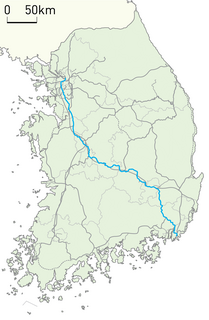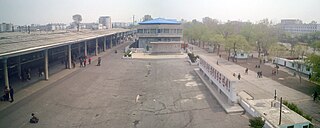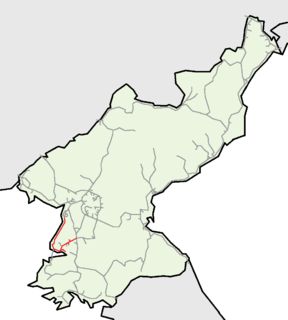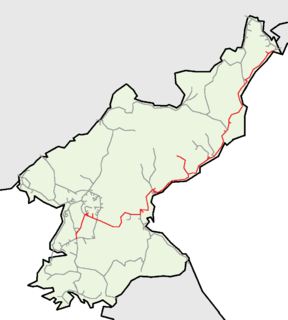
The Gyeongbu Line (Gyeongbuseon) is the most important railway line in South Korea and one of the oldest ones in the country. Gyeongbu line was constructed in 1905, connecting Seoul with Busan, via Suwon, Daejeon, and Daegu. The Gyeongbu Line is by far the most heavily travelled rail line in South Korea.

The Gyeongin Line (Gyeonginseon) is a railway mainline in South Korea, currently connecting Guro Station in Seoul and Incheon. Commuter services along the line through operates into Seoul Subway Line 1.

The Gyeongui Line is a railway line between Seoul and Dorasan Station in Paju. Korail operates the Seoul Metropolitan Subway service between Seoul Station and Munsan Station.

Yongsan station is a major railway station in Seoul, South Korea. It is located in Yongsan District, and adjoins the Yongsan Electronics Market. The station is the terminus for high-speed and long-distance trains on a number of railway lines, including most trains on the Honam Line, its high-speed counterpart, and all trains on the Janghang and Jeolla Lines.

Dongdaegu Station, meaning "East Daegu Station", is a railway station in Daegu, South Korea. It is on the national high-speed KTX railway network, 282 km (175 mi) south of Seoul Station.

Saint Kim Taegon Andrew, generally referred to as Saint Andrew Kim Taegon in English, was the first Korean-born Catholic priest and is the patron saint of Korea. In the late 18th century, Roman Catholicism began to take root slowly in Korea and was introduced by scholars who visited China and brought back Western books translated into Chinese. In 1836 Korea saw its first consecrated missionaries arrive, only to find out that the people there were already practicing Korean Catholics.

Dorasan Station is a railway station situated on the Gyeongui Line, which used to connect North Korea and South Korea and has since been restored. Dorasan Station is located approximately 650 meters from the southern boundary of the Korean Demilitarized Zone and is currently the northern terminus of Korail's Gyeongui Line, which is served by Tonggeun commuter trains. North of here the former Gyeongui Line continues as the Korean State Railway's P'yŏngbu Line, but this connection is not in regular service. The current purpose of the station is largely symbolic of the hope for eventual Korean reunification.

The P'yŏngŭi Line is an electrified main trunk line of the Korean State Railway of North Korea, running from P'yŏngyang to Sinŭiju on the border with China. It is the main corridor for overland traffic between North Korea and China, and is one of the country's most important rail lines. A bridge over the Yalu River connects Sinŭiju to the Chinese city of Dandong and the Shendan Line of the China Railway to Shenyang and Chinese points beyond.

Sinuiju Chongnyon Station, also known as Sinŭiju Ch'ŏngnyŏn Station, is a railway station in Yŏkchŏn-dong, Sinŭiju-si, North P'yŏngan Province, North Korea. It is the northern terminus of the P'yŏngŭi Line of the Korean State Railway, and the starting point of the Kang'an Line, which is an industrial line serving the factories of Sinŭiju.

The Korean State Railway is the operating arm of the Ministry of Railways of the Democratic People's Republic of Korea and has its headquarters at P'yŏngyang. The current Minister of Railways is Chon Kil-su, who has held the position since 2009.

The P'yŏngnam Line is an electrified standard-gauge trunk line of the Korean State Railway in North Korea, linking P'yŏngyang with the port city of Namp'o and the hot springs at P'yŏngnam Onch'ŏn. The length of the line is 89.9 km (55.9 mi).
Rajin Station is a railway station in Rajin-guyŏk, Rasŏn Special City, North Korea. It is the junction point and terminus of both the Hambuk and P'yŏngra lines of the Korean State Railway. It is also the starting point of a freight-only branchline to Rajin Port Station.

The P'yŏngdŏk Line is an electrified standard-gauge trunk line of the Korean State Railway in North Korea running from Taedonggang Station in P'yŏngyang, where it connects to the P'yŏngbu, P'yŏngnam, P'yŏngra and P'yŏngŭi Lines, to Kujang, where it connects to the Manp'o and Ch'ŏngnyŏn P'arwŏn Lines. The total length of the line is 192.3 km (119.5 mi).
The Ŭnsan Line is an electrified standard-gauge freight-only secondary line of the Korean State Railway in South P'yŏngan Province, North Korea, running from Ŭnsan on the P'yŏngra Line to Taegŏn.
Oedong Station is a railway station in Oedong-ri, Kaech'ŏn county, South P'yŏngan province, North Korea, on the Taegŏn Line of the Korean State Railway.
Taegŏn Station is a railway station in Chŭngsan-dong, Sunch'ŏn city, South P'yŏngan Province, North Korea, on the Taegŏn Line of the Korean State Railway, where it connects with the Ŭnsan Line to Ŭnsan on the Pyongra Line. It is also the starting point of the Chiktong Colliery Line to the colliery at Chiktong T'an'gwang and of the Mohak Line to Mohak.
The Mohak Line is an electrified standard-gauge freight-only secondary line of the Korean State Railway in South P'yŏngan Province, North Korea, running from Taegŏn on the Ŭnsan Line to Mohak, where it serves the large Sunch'ŏn Cement Complex.
The Chiktong T'an'gwang Line, or Chiktong Colliery Line, is an electrified standard-gauge secondary line of the Korean State Railway in South P'yŏngan Province, North Korea, running from Taegŏn Station at the junction of the Taegŏn and Ŭnsan lines to Chiktong T'an'gwang. The line serves the Pusan Aluminium Factory at Pusalli, as well as the large 8 February Chiktong Ch'ŏngnyŏn Colliery at Chiktong T'an'gwang.

The Taegŏn Line is an electrified standard-gauge secondary line of the Korean State Railway in South P'yŏngan Province, North Korea. It runs from Sillyŏnp'o Station on the P'yŏngra Line via Taegŏn on the Ŭnsan Line to Pongch'ang.
The Mikashi-class (ミカシ) locomotives were a group of steam tender locomotives of the Chosen Government Railway (Sentetsu) with 2-8-2 wheel arrangement. The "Mika" name came from the American naming system for steam locomotives, under which locomotives with 2-8-2 wheel arrangement were called "Mikado" in honour of the Emperor of Japan, as the first 2-8-2 locomotives in the world were built for Japan.
















